Content available at:
Español (Spanish) Português (Portuguese (Brazil))
The management of males is crucial due to its impact on the productive results of broiler breeders, and also because it presents more difficulties due to the great selection pressure they are subjected to in order to improve meat characteristics of broilers, as well as growth rate, breast development and feed conversion.
In order to accomplish this, we must know what the best management practices are, taking into account that when we talk about male management, we are referring to a mixture of knowledge of what we have to do, scientific knowledge of the physiological processes involved in their development, and of course a certain dose of art.
The first days of life are key for the good development of the bird, since a good early growth favors a better initial uniformity
Tarsal length and early development of bone structure have a strong influence on fertility.
Start
It is very important that the start of the chicks is made adequate with good feed quality in the first six weeks. A balanced feed between energy and crude protein, complying with the ideal protein profile recommended by the management guide and with a good particle size in the form of crumbs or mash, helps the weight standards of days 7-14-21- 28 to be easily reached and even exceed by 20-30 g, helping the birds’ development in:
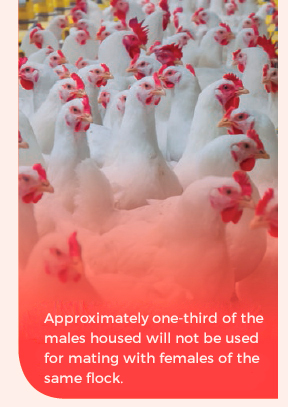
During the rearing period we must take care about:
Normally, the males are housed at a ratio of 15% to females, and it is usually recommended that no more than 9-10% of males mate with the housed hens. It should be planned beforehand whether or not the remaining males are to be used for spiking* in an older flock.
In case you are not going to do spiking, a good selection of males becomes mandatory. This will allow us to reduce their density throughout the rearing.
Selection of broiler breeder males
The first selection is recommended to be made at 7 weeks of age, reducing the ratio of roosters to 13%. At 14 weeks it is recommended to make a second selection, lowering the ratio to 11%.
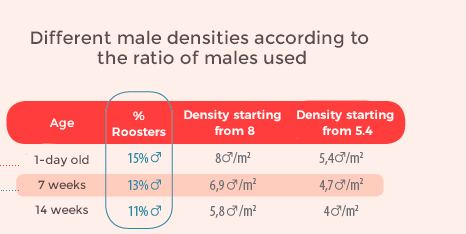
If we started from 5.4 males per m2, we would end up with 4 males / m2, lowering the ratio of males from 15 to 11%, so the selection is of greater importance when we have a higher density in the beginning.
In case of spiking, we will not be able to reduce the ratio of roosters, and it will be necessary to have more surface for housing them from the start, or move the spiking roosters at 12-14 weeks to a house prepared to accommodate them.
The recommendation for male density is 3-4 males / m2, since this greatly impacts on feather quality, skeleton development, uniformity and reduction of aggressive behavior, which eventually determines the quality of males as well as their potential fertility. 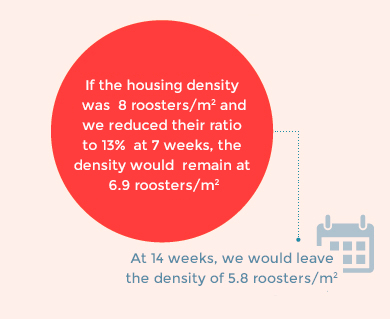
Feeding management: Feeding in the dark
Another very important aspect is male management is the feeding, as the daily ration quantities are often too small to be transported and distributed efficiently around the entire trough circuit, which can cause problems in achieving uniform feed distribution.
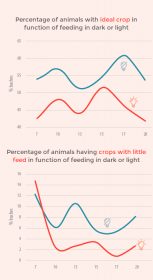
Once the feed has been distributed, light can be given for a few seconds, usually 30-45 seconds, to facilitate uniform distribution of the males by the feeder surface.
Afterwards, the light is turned off again and the feed is consumed in the dark, achieving a better uniformity of the crops, preventing the more aggressive males from interfering with the less dominant males in the social order during feeding, since they are only concerned with finding the feed and not with competing with other males.
The weight of the male is the individual factor that has the greatest correlation with the fertility of the flock. To achieve good weight control, after housing the males together with the females, it is necessary to ensure effective feeding separated by sexes.
Starting at 21 weeks of age, chicken feeders have to exclude males, which is perhaps the most important factor in successfully achieving control of male body weight.
Roosters are becoming more efficient with feed conversion: they have a higher intake capacity and more appetite, which makes them more anxious to steal feed from the hens’ troughs, which is important in the first weeks after housing them on the production farms, while they still have underdeveloped combs.
We can train the males during rearing, by having them eat from the same type of feeder that will be used in production.
Goals during production
When transferring the roosters to the production farm, the last selection must be made, eliminating:
Many of these males could mount, but the percentage of complete mounts is much lower than in males without defects.
Males who gain a lot of weight early after transfer are those who first start their sexual development and may behave more aggressively towards females, which causes them to reject them and increase the number of incomplete copulations.
The amount of feed that males are able to steal from the chicken feeder depends on:
In order to have an effective gender segregated feeding, the access hole to the feed in the chicken feeders has to be as closed as possible.
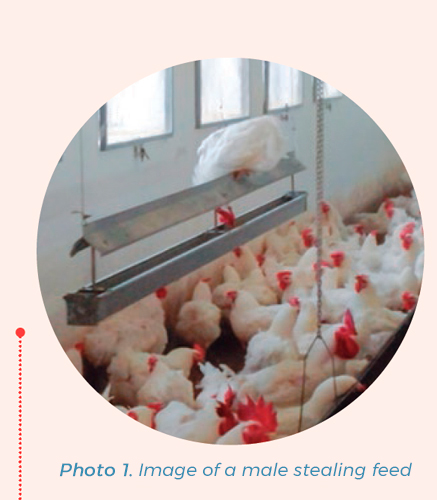
In the case of chicken plate feeders, the opening must be adjusted to a minimum both horizontally and vertically and gradually opened as the roosters continue to develop their combs.
In the case of trough feeders, the limit will depend the size of the grids. We recommend a width of 45 mm and a height of 60 mm, but there are still males who are able to fit their heads into the hole in the grate, even injuring their combs in the process.
This usually occurs for three or four weeks after the transfer to the production farm, and to avoid this in many farms a PVC tube of about 15 mm in diameter is placed on top of the grids, thus reducing their heights and very effectively preventing roosters access to the hens’ trough feeder. Once the rooster comb has developed, the PVC pipe should be removed to prevent the chickens from getting injured.
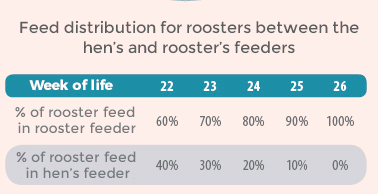
When the feeding system separated by sexes is not effective, you can always distribute a part of male’s feed in the hens’ feeder depending on what we think they can steal, and reduce it weekly as they stop stealing and that will depend on the development of the roosters’ combs.
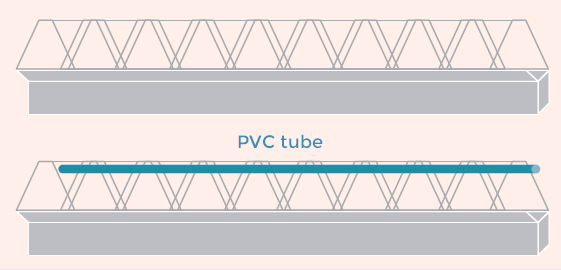
Figure 1. Diagram showing the location of the PVC pipe in the grid of the female trough feeder
Separate feeding system
For a few years we have been using a 100% effective separate feeding system on grandparent and breeder farms. Corridors are created on both sides of the house, where the males are housed with special lines of feeders and drinkers, and are totally separated from the part of the house where the hens are kept.
They are kept separate from the hens until the first egg appears in the house, which is usually 18 days after photostimulating the birds.
The separate feeding system allows us to gradually add males after the first egg appears, releasing 5% of the roosters, selecting the roosters that have the most developed secondary sexual signs (comb and wattles) since they can mount earlier, although they have more aggressive behavior within the corridors and when removing them will allow the smaller roosters to grow without competition or aggression from more developed roosters. The following week the other 25% of roosters are removed and a week later the remaining 25%
System objective
Efficient feeding by separating sexes during the period when males are most at risk of stealing feed from hens and gaining excess weight rapidly. Progressive addition of males when the hens have already started to lay, reduces the rejection of the females to be mounted and the aggressive behavior of the roosters.
To make the corridors for the cores, two taut guides are placed – one on the floor and the other at a height of approximately 1.8 metres along the length of the building – and about one metre away from the wall. Along the guides and hooked with carabiners, a net is attached that can be moved along the line increasing or decreasing the size of the corridor.
The separate feeding system allows the area of the corridor to be adjusted to the number of males inside. The more males in the hall, the smaller the size of the corridor. When all males are out, they can be picked up at one end of the hall and if we need to put them back in, it is as simple as sliding the net along the guides. If we receive spiking males from another flock of younger breeders; normally 21-22 weeks old, we can house them in this male corridor until they are sexually developed enough to move into the house with the hens and compete with the older roosters.
Subscribe now to the poultry technical magazine
AUTHORS

Layer Longevity Starts at Rearing
H&N Technical Team
The Strategy for a Proper Infectious Bronchitis Control
Ceva Technical Team
Elevate Hatchery Performance with Petersime’s New Data-Driven Incubation Support Service
Petersime Technical Team
Maize and Soybean Meal Demand and Supply Situation in Indian Poultry Industry
Ricky Thaper
Production of Formed Injected Smoked Chicken Ham
Leonardo Ortiz Escoto
Antimicrobial Resistance in the Poultry Food Chain and Novel Strategies of Bacterial Control
Edgar O. Oviedo-Rondón
GREG TYLER INTERVIEW
Greg Tyler
Insights from the Inaugural US-RSPE Framework Report
Elena Myhre
Newcastle Disease: Knowing the Virus Better to Make the Best Control Decisions. Part II
Eliana Icochea D’Arrigo
Avian Pathogenic E. coli (APEC): Serotypes and Virulence
Cecilia Rosario Cortés
The Importance of Staff Training on Animal Welfare Issues in Poultry Industry
M. Verónica Jiménez Grez
Rodent Control is a Key Factor in Poultry Biosecurity and Sustainability
Edgar O. Oviedo-Rondón